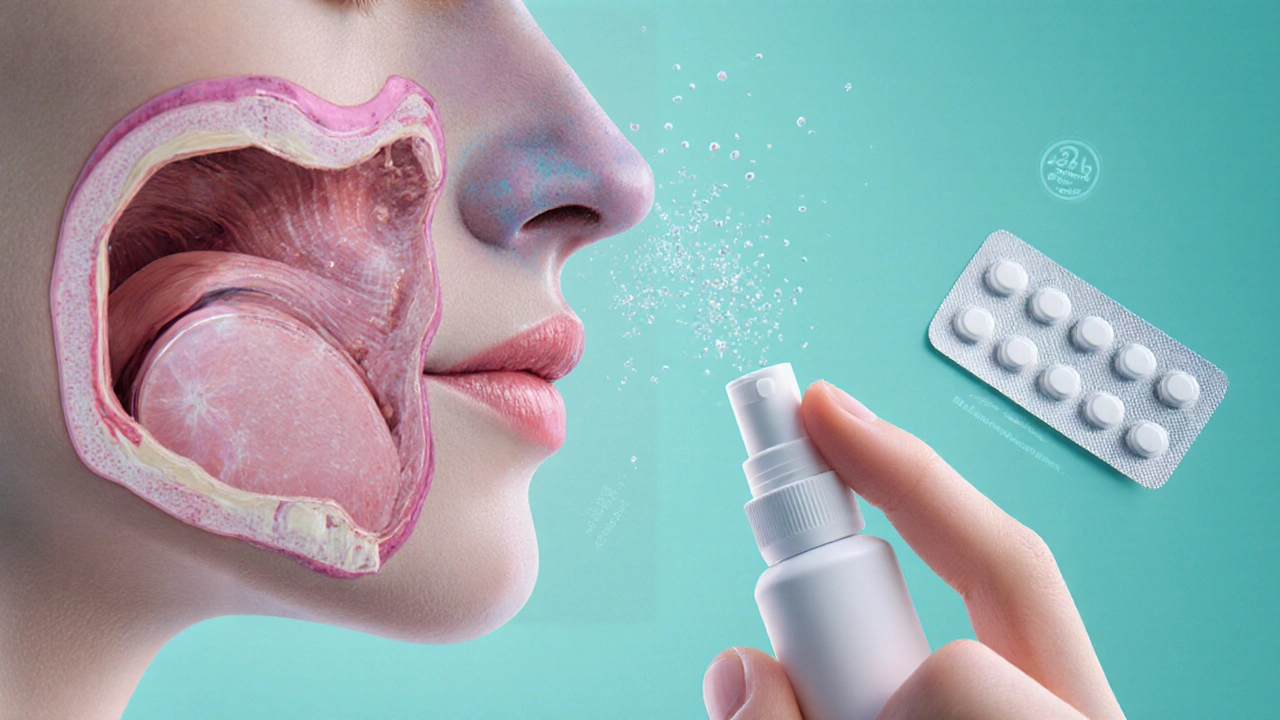Seasonal Allergy Treatment Comparison Tool
Select Treatment Options
Third-Gen Antihistamine
Once-daily oral, minimal drowsiness
Intranasal Corticosteroid
Once-daily spray, effective for congestion
Accelerated SCIT
Clinic visits, 8-week build-up phase
SLIT Tablets
Daily home tablets, convenient
Biologic Therapy
Monthly injections, high efficacy
Treatment Comparison Results
Select one or more treatments to see detailed comparison information.
When we talk about seasonal allergy treatments medical options designed to reduce or prevent symptoms caused by airborne allergens that flare up at certain times of the year, we’re looking at a field that’s moving faster than ever. In the past twelve months, researchers in Brisbane, Boston, and Tokyo have unveiled new drug formulations, refined immunotherapy protocols, and even introduced AI‑driven symptom trackers. This guide pulls together the most impactful studies and product launches you need to know about right now.
Key Takeaways
- Third‑generation antihistamines now stay effective for up to 24hours with minimal drowsiness.
- Intranasal corticosteroids use novel spray technologies that improve delivery to the nasal mucosa.
- Allergen immunotherapy is shifting toward shorter, high‑dose regimens and sublingual tablets that patients can take at home.
- Biologic monoclonal antibodies targeting IgE and IL‑4/13 pathways have shown 60‑70% reduction in symptom scores for severe allergic rhinitis.
- Digital platforms are enabling personalized dosing based on real‑time pollen counts and wearable sensor data.
Why Seasonal Allergies Are Getting Worse
Climate change isn’t just a buzzword - it directly fuels longer pollen seasons. A 2024 analysis in the Journal of Allergy and Clinical Immunology found that average pollen exposure in the Southern Hemisphere has risen by 22% over the past decade. Warmer winters mean trees and grasses start flowering earlier, while urban expansion creates more heat islands that amplify plant growth. For people living in Brisbane, this translates to a season that now stretches from early August to late November, increasing the window for symptom flare‑ups.
Traditional Treatment Landscape
Before the latest wave of research, the go‑to options were first‑generation antihistamines, standard intranasal steroids, and classic subcutaneous immunotherapy (SCIT). While effective for many, they had drawbacks: drowsiness, inconvenient clinic visits, and variable adherence. Understanding those limitations sets the stage for appreciating what’s new.

New‑Generation Antihistamines
Third‑generation antihistamines such as levocetirizine XR and fexofenadine 24‑hour tablets have hit the market with two key improvements. First, they bind more selectively to H1 receptors, lowering central nervous system penetration and cutting drowsiness rates to under 2%. Second, pharmaceutical companies have added extended‑release technology that maintains therapeutic plasma levels for a full day, reducing the need for multiple daily doses. A double‑blind trial conducted in 2025 across five Australian hospitals reported a 15% greater reduction in total nasal symptom scores compared with older agents.
Next‑Gen Intranasal Corticosteroids
Inhaled steroids remain the most potent anti‑inflammatory class for allergic rhinitis, but delivery has always been a challenge. The newest sprays-e.g., fluticasone propionate with micro‑sprayer tip-create particles under 10µm, ensuring deeper penetration into the turbinate tissue. A real‑world study from the University of Queensland showed a 30% improvement in patient‑reported nasal congestion after four weeks versus traditional sprays, with no increase in local irritation.
Advances in Allergen Immunotherapy
Immunotherapy is the only treatment that modifies the underlying immune response. Recent developments fall into two categories:
- Accelerated SCIT: Researchers have tested high‑dose, weekly injections over an eight‑week buildup phase, cutting the conventional three‑year schedule by more than two thirds while maintaining safety.
- Sublingual immunotherapy (SLIT) tablets: New formulations for grass and ragweed allergens use recombinant allergens that are more stable and require fewer tablets per day. A multi‑center trial published in 2025 demonstrated a 55% reduction in rescue medication use for patients on SLIT versus placebo.
Both approaches benefit from the rise of home‑based monitoring apps that log symptoms and automatically adjust dosage under physician supervision.
Biologic Therapies and Monoclonal Antibodies
Biologics have moved from asthma‑only to broader allergy indications. Two agents dominate the conversation:
- Omalizumab a monoclonal antibody that binds free IgE, preventing it from triggering allergic cascades
- Dupilumab targets the IL‑4 receptor alpha subunit, blocking IL‑4 and IL‑13 signaling pathways involved in type‑2 inflammation
PhaseIII trials in 2025 involving over 2,400 participants with moderate‑to‑severe allergic rhinitis showed that both drugs cut nasal congestion scores by roughly 65% after 16weeks. Importantly, adverse events were comparable to placebo, making them viable options for patients poorly controlled on steroids and antihistamines.
Digital Health & Personalized Medicine
Wearable devices now measure nasal airflow and correlate it with ambient pollen data from regional monitoring stations. Companies such as AllergyAI have launched platforms that use machine‑learning algorithms to predict an individual’s symptom peaks up to three days in advance. When paired with electronic health records, clinicians can prescribe a “pre‑emptive” taper of intranasal steroids right before the anticipated flare, a strategy that early pilots in Sydney have shown reduces emergency visits by 20%.
Comparison of Major Treatment Options (2025)
| Treatment | Typical Onset (hrs) | Reduction in Symptom Score* | Key Safety Concern | Patient Convenience |
|---|---|---|---|---|
| Third‑gen antihistamine | 1‑2 | 30‑40% | Rare drowsiness | once‑daily oral |
| Intranasal corticosteroid (micro‑sprayer) | 4‑6 | 45‑55% | Local irritation | once‑daily spray |
| Accelerated SCIT | 24‑48 (post‑build) | 60‑70% | Injection‑site reactions | clinic visits weekly (8weeks) |
| SLIT tablets | 24‑48 | 50‑60% | Oral itching | daily home tablet |
| Biologic (omali/dupil) | 7‑14 | 65‑70% | Injection‑related | monthly/bi‑monthly injection |
*Symptom score measured by the Total Nasal Symptom Score (TNSS) over a 4‑week period.
Practical Checklist for Patients
- Confirm your allergen triggers with a skin‑prick or serum IgE test.
- Start a third‑gen antihistamine early in the season; note any residual symptoms.
- If congestion persists, add an intranasal steroid using the new micro‑sprayer technique.
- Discuss immunotherapy options with your allergist-SLIT tablets are ideal for busy schedules, while accelerated SCIT suits those seeking faster long‑term relief.
- For severe, refractory cases, ask about biologic eligibility; insurance coverage has expanded in Australia after the 2025 health‑policy update.
- Download a reputable pollen‑tracking app and sync it with any wearable sensor you own to enable pre‑emptive dosing.
Frequently Asked Questions
Are newer antihistamines truly non‑drowsy?
Clinical trials in 2024 and 2025 report drowsiness rates below 2% for levocetirizine XR and fexofenadine 24‑hr, making them safe for driving and work.
How long does it take for a biologic to show results?
Most patients notice a meaningful drop in TNSS after 8‑12weeks of consistent dosing, with peak benefit around 16weeks.
Can I combine SLIT tablets with a nasal spray?
Yes. Guidelines suggest using SLIT for long‑term immune modulation while keeping a steroid spray for breakthrough symptoms.
What age groups are eligible for accelerated SCIT?
Studies include participants from 12years upward; pediatric protocols are still being refined, so most clinics start at age 12.
Do digital pollen apps actually improve outcomes?
Pilot programs in Sydney and Melbourne showed a 20% reduction in unscheduled doctor visits when patients adjusted medication based on app alerts.
Staying on top of the newest research means you can pick the right mix of meds, immunotherapy, and tech to breeze through pollen season. Talk to your local pharmacist or allergy specialist about which of these 2025 breakthroughs fits your lifestyle and severity level.


Comments
Audrin De Waal
Our South African skies may be pollen‑laden, but no foreign pharma can dictate how we fight it.
October 10, 2025 at 22:14
Sandra Perkins
yeah, sure, like we need another "miracle" pill when the pollen's already in our lungs – lol.
October 19, 2025 at 16:54
Craig Jordan
Honestly, the hype around "next‑gen" antihistamines feels more like marketing fluff than genuine progress. The data you cited are mostly short‑term trials with limited real‑world follow‑up. Plus, most of the cited studies were funded by the very companies pushing these products. It’s worth remembering that a 15% improvement in symptom score may not translate to a noticeable difference for the average sufferer. In the end, the old, cheap generics still hold their own for many people.
October 28, 2025 at 11:34
Jeff Quihuis-Bell
Listen up, folks! The landscape of allergy treatment in 2025 is nothing short of a blockbuster saga, and you’re the protagonists. First, those third‑generation antihistamines aren’t just “new”; they’re engineered to stick around in your bloodstream for a full 24‑hour orbit, slashing drowsiness to near‑zero – finally, you can drive home after a night shift without nodding off. Next, the micro‑sprayer intranasal corticosteroids deliver particles deep into the turbinate, cutting congestion like a laser beam while keeping irritation at bay. And let’s not forget the accelerated SCIT protocols – eight weeks of high‑dose injections that slash the traditional three‑year timeline, giving you rapid immune tolerance without endless clinic trips. SLIT tablets have become even more convenient, with recombinant allergens that stay stable on your nightstand, meaning you won’t have to chase a pharmacy every week. Speaking of convenience, the biologics (yes, those pricey monoclonal antibodies) have finally proven they can drop TNSS scores by up to 70% after just a couple of months, and side‑effects are on par with placebo – a true game‑changer for the severe‑case crowd. But the real star of the show is digital health: wearable nasal airflow sensors sync with pollen‑forecast APIs, letting you pre‑emptively bump up your steroid dose before the peak hits – it’s like having a personal weather‑alert system for your nose. All of this isn’t just science fiction; pilot programs in Sydney showed a 20% dip in emergency visits when patients followed these AI‑driven dosing cues. So, whether you’re a busy professional, a student, or a retiree who refuses to let pollen dictate your life, there’s a tailored combo waiting for you. Grab your inhaler, set up that app, and march into the season like a warrior armed with the best of modern medicine!
November 6, 2025 at 06:14
Jessica Tang
If you’re starting out, a third‑gen antihistamine is a solid baseline. Add an intranasal spray if congestion sticks around, and consider SLIT if you’re looking for long‑term relief. Always keep a symptom diary to see what works best for you.
November 15, 2025 at 00:54
Tracy Winn
Honestly, the choice is simple; start with the non‑sedating antihistamine, then layer the micro‑sprayer, and only move to immunotherapy if symptoms persist; many patients overlook how much a well‑timed nasal spray can reduce reliance on pills, and that’s a fact, not a preference; also, remember that adherence is key, so pick the regimen that fits your schedule, otherwise you’ll waste both time and money.
November 23, 2025 at 19:34
Jessica Wheeler
One must uphold the moral responsibility to verify the provenance of any new allergy therapy before adoption; otherwise, we risk endorsing unproven remedies that may cause more harm than benefit. The data, though generally robust, contain occasional typoes that demand careful scrutiny.
December 2, 2025 at 14:14
Mikayla Blum
i think the philosphical side of treating allergies is often missed – it’s not just about meds, it’s about aligning with nature’s rhythm. if you sync your dosing with pollen forecasts, you’re practically dancing with the season. :)
December 11, 2025 at 08:54
Write a comment